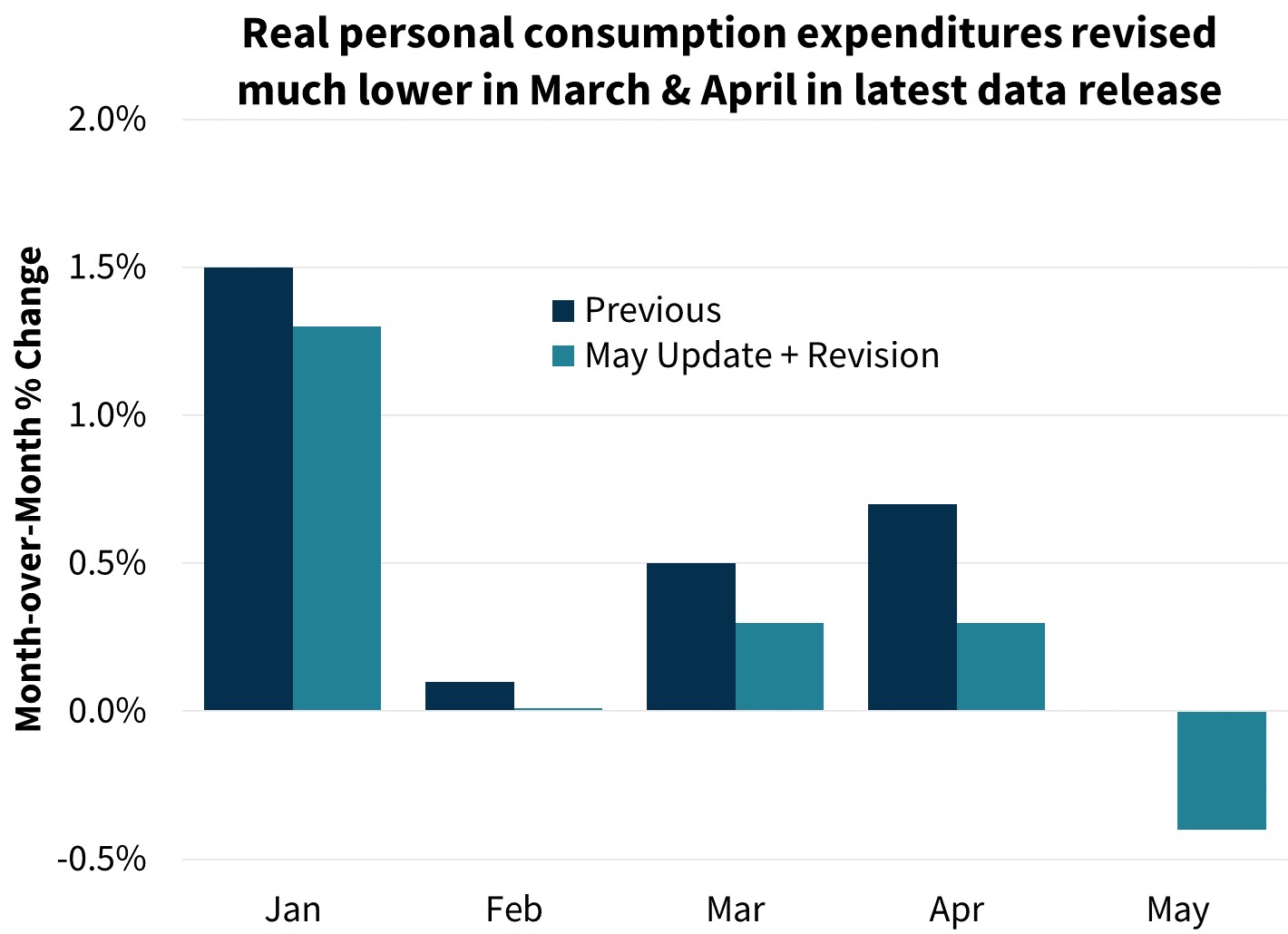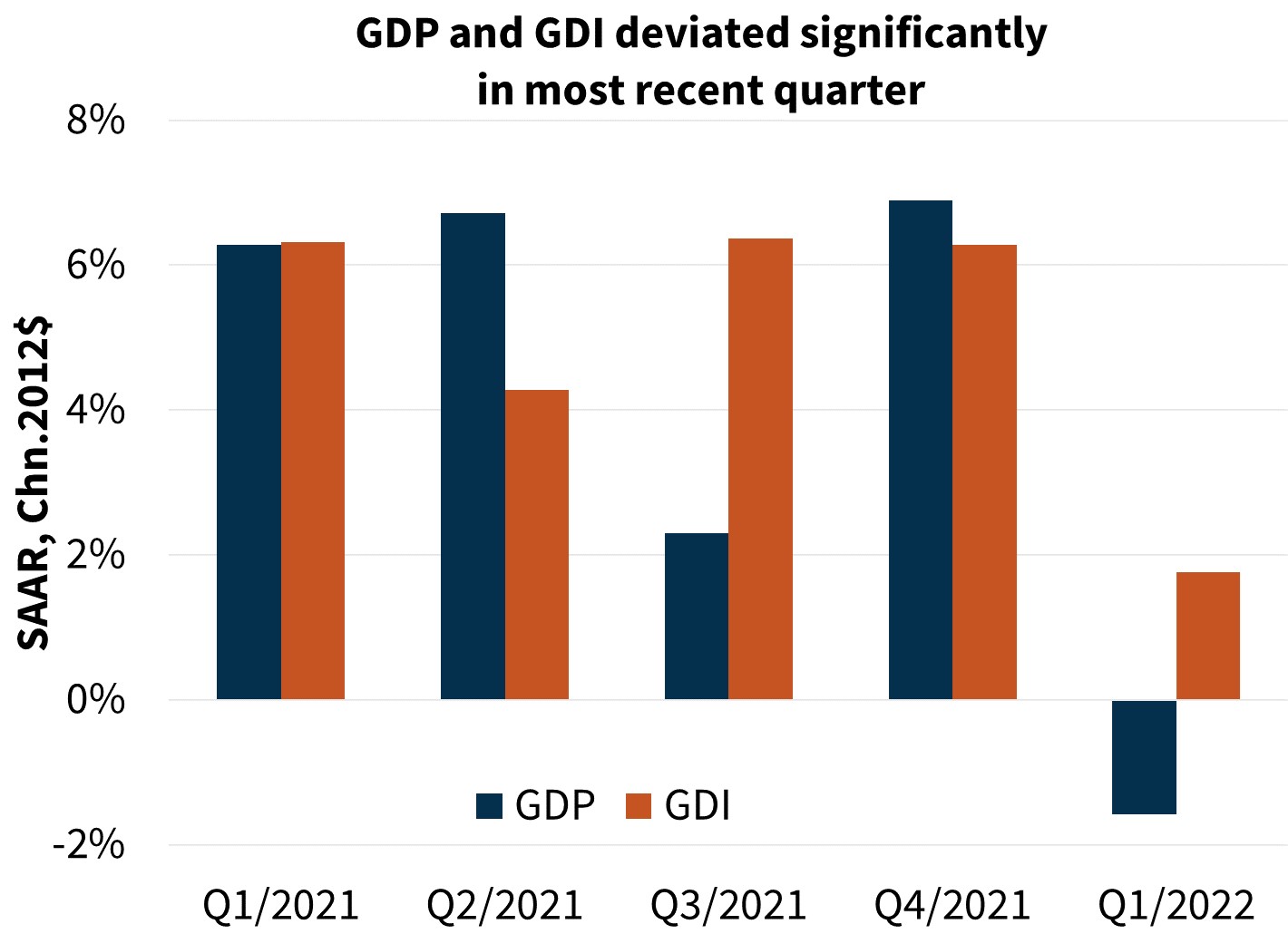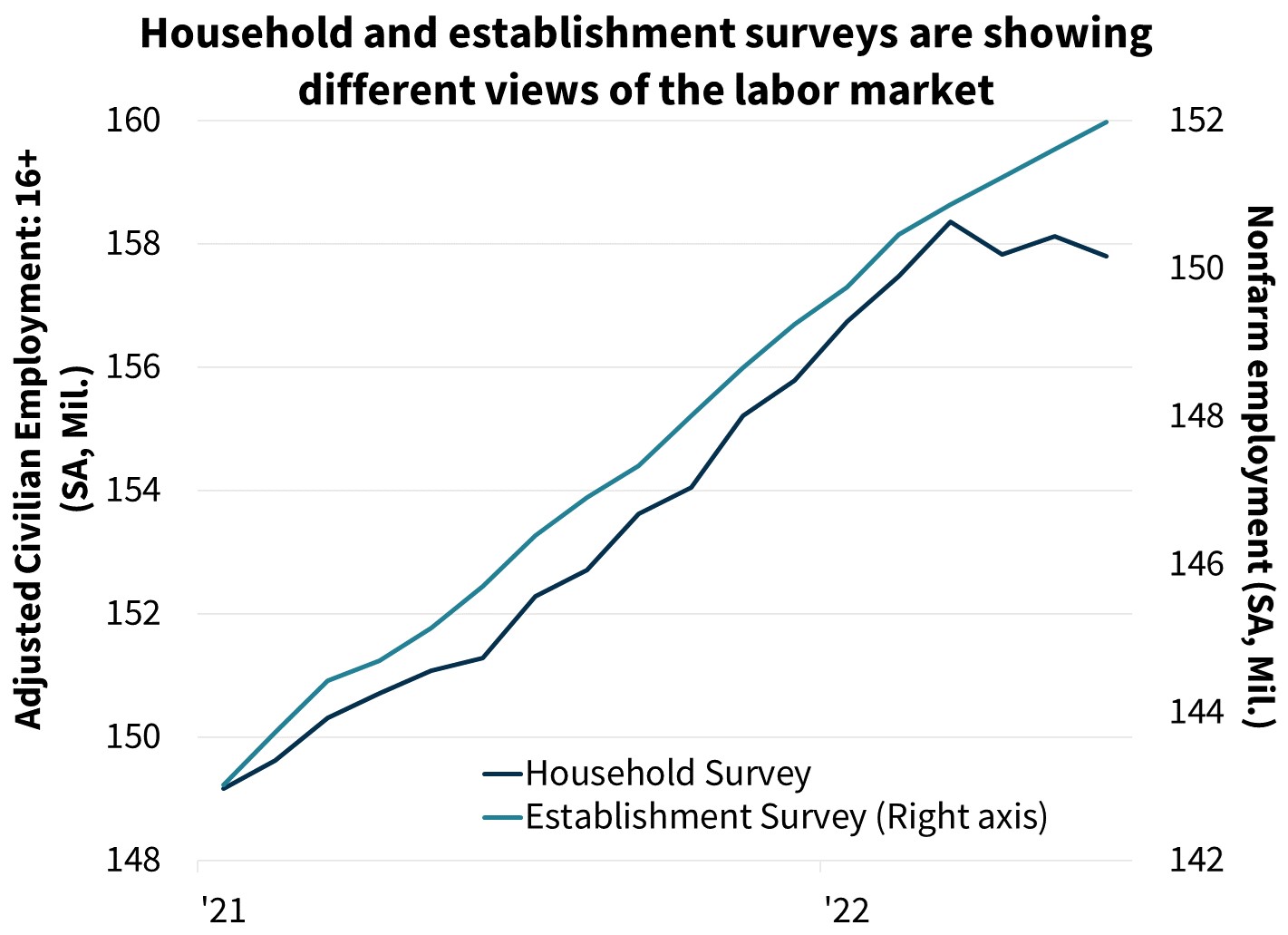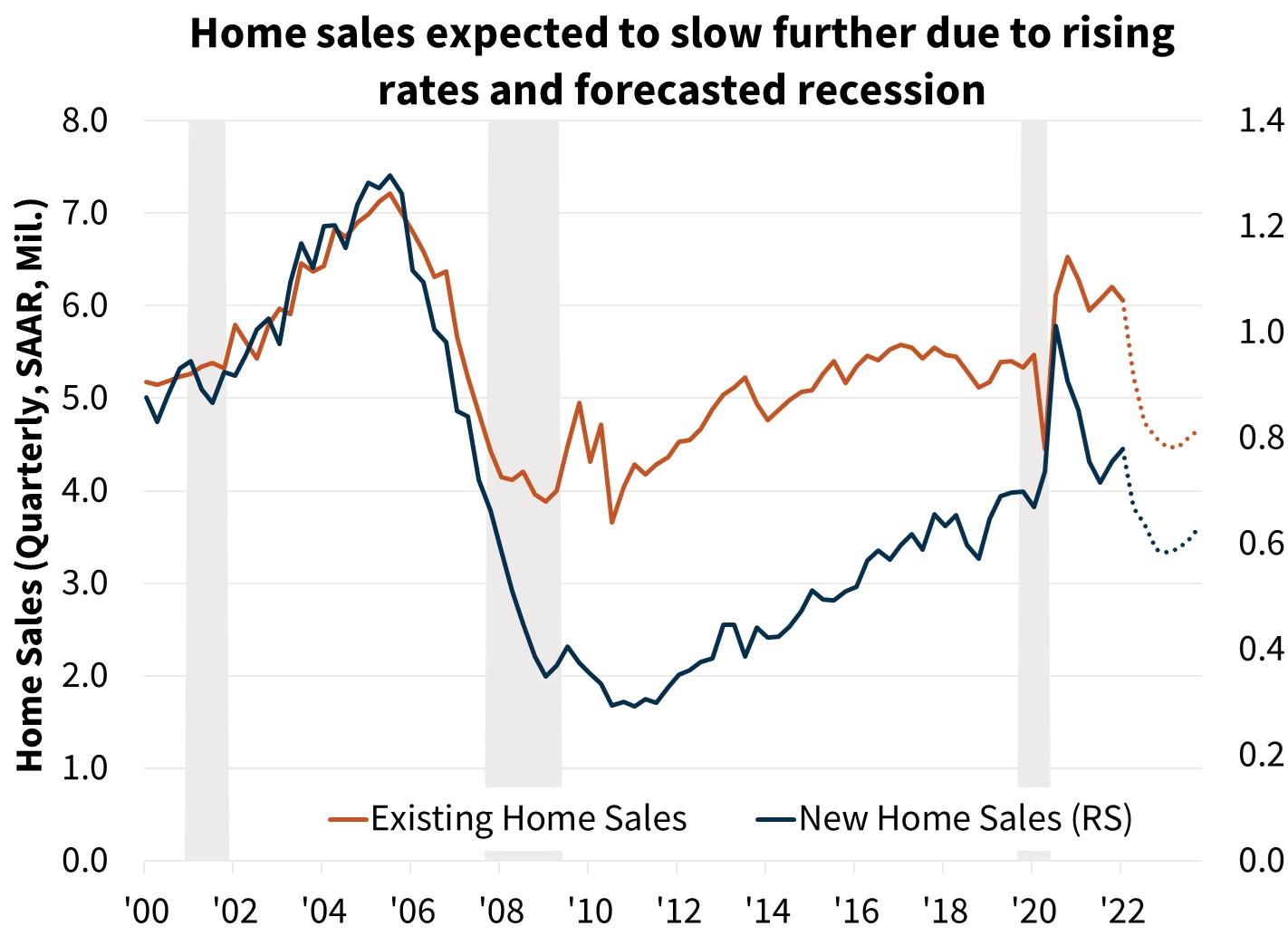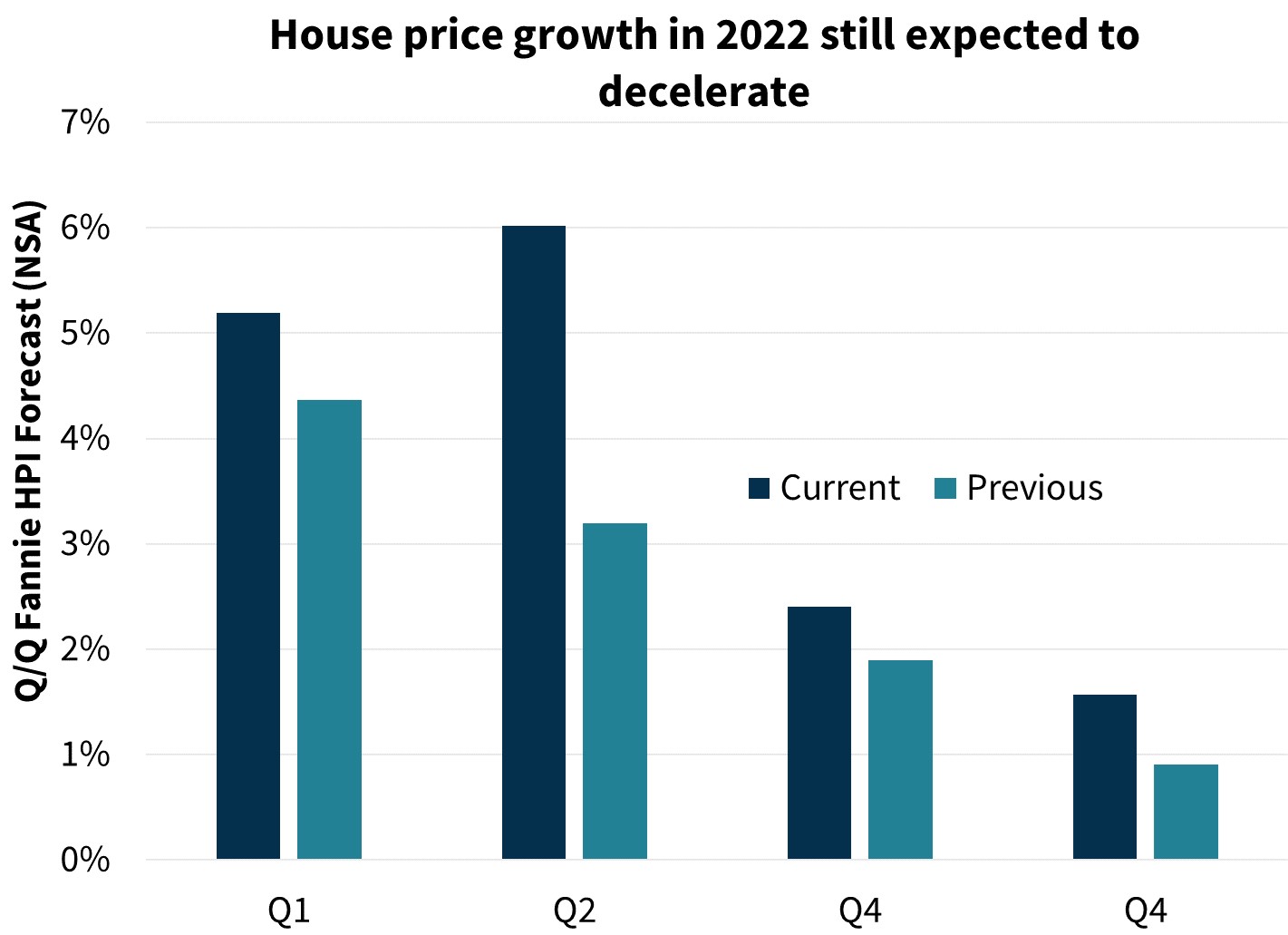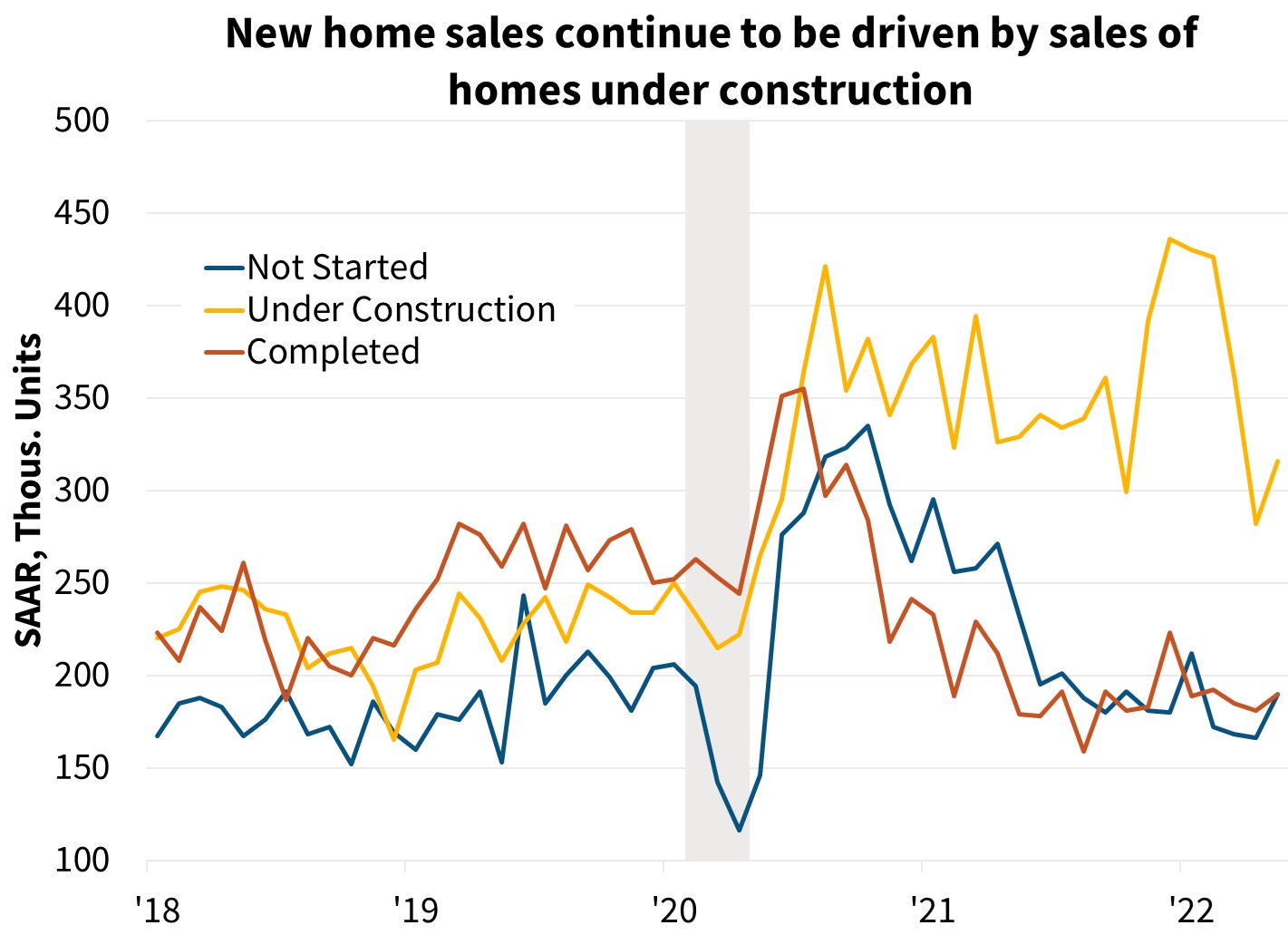Economic Growth Stagnating in Face of High Inflation
Our forecast for real gross domestic product growth (GDP) in 2022 was revised to just 0.1 percent on a Q4/Q4 basis, down from our previous forecast of 1.2 percent growth. This was largely driven by recent incoming data revisions pointing to a modest contraction of GDP in the second quarter as decades-high inflation and rising interest rates weigh on consumers and firms. While we do not believe a recession has yet begun, economic growth is clearly stagnating alongside high inflation. With the full effects of monetary and fiscal policy tightening still working through the economy, we now expect a modest recession to begin in Q1 2023 as opposed to our previous expectation of it occurring in the latter half 2023. Thus, our forecast for 2023 GDP growth was revised downward to negative 0.4 percent from a previous negative 0.1 percent. We forecast the unemployment rate will rise to around 5.5 percent by the end of 2023 compared to the current level of 3.6 percent.
Our lower GDP forecast means we also revised downward our year-end inflation outlook on softening prices for durable goods, energy, and other commodities, in addition to slower wage growth as economic activity weakens. We forecast the Consumer Price Index (CPI) will rise 5.7 percent in 2022 on a Q4/Q4 basis (down from 7.3 percent) and the core measure will be 5.0 percent higher (5.1 percent previously). Note that following the completion of our forecast, the CPI reading for the month of June came in higher than expected, meaning that there is upside risk to our near-term inflation outlook.
Additionally, we revised lower our forecast for total home sales in 2022 to 5.82 million units, a 15.6 percent decline from 2021 and steeper than our previous forecast of a 13.5 percent drop. Sales expectations for 2023 were revised downward to a pace of 5.15 million units, from 5.29 million. In contrast, our quarterly update of our home price forecast was revised upward for 2022 to 16.0 percent growth on a Q4/Q4 basis, up from a previous 10.8 percent. The change was in large part driven by stronger incoming actual price growth through Q2, which increased on a non-seasonally adjusted basis by 11.2 percent, compared to our previous forecast of 7.7 percent. We still anticipate a strong deceleration in house price growth going forward as the lagged effects of higher mortgage rates and a slowing economy weigh on home purchase demand. Following completion of our forecast, some more recent market indicators suggest that home price growth could moderate at a faster pace than currently projected. Taking both sales and home price forecast changes into account, we have revised lower our forecast for 2022 mortgage originations to $2.53 trillion (previously $2.60 trillion), while slightly upwardly revising 2023 forecast originations to $2.22 trillion (previously $2.20 trillion), respectively. For the latter, a higher home price outlook outweighed a lower sales forecast.
Downward Revisions to Data Point to Q2 GDP Contraction
We now expect that second quarter 2022 GDP declined at an annualized pace of 1.4 percent, down from our previous forecast of 2.5 percent growth. This substantial change was driven principally by a contraction in real personal consumption expenditures data for the month of May, which fell 0.4 percent, as well as large downward revisions to the readings for March and April. This more recent data paints a picture of a far less resilient consumer in the face of high inflation than previously thought. As a secondary factor, revisions to first quarter GDP also revealed that business inventory restocking was stronger over the period than previously reported, meaning that there is now less need for firms to continue to build inventory. Comments from major retailers suggesting they are holding more than the desired level of stock for certain items supports this notion. Inventory investment was a major driver of growth over recent quarters, so an anticipated slowdown will now drag on GDP growth moving forward.
One of the ongoing risks to the forecast is determining how consumers will behave in light of two key competing factors. On one hand, despite strong nominal wage gains, inflation-adjusted incomes have been flat to negative in recent months, weighing on discretionary spending. On the other hand, in aggregate, households continue to have a large built-up stock of savings in their checking accounts and remain less leveraged than they were prior to the onset of the COVID-19 pandemic. This suggests that households can continue to dip into savings and take on more debt to drive consumption in the near term. In fact, outstanding revolving credit balances have been rising in recent months and are up 6.7 percent through May since December 2021. It is uncertain, however, how much further consumers will be able and willing to do this, leading to near-term risk to our GDP forecast in both directions. Built-up savings are not distributed equally, and many more modest-income households have exhausted their previously built-up savings at this point and may not have access to additional credit. Furthermore, in part due to recession-like low levels of consumer confidence, many consumers able to drive spending growth may not be willing to do so, which remains a risk going forward. However, given recent data trends such as June retail sales and the more recent pull back in energy prices since June, which should help real income growth in July, we forecast real personal consumption will grow modestly moving into Q3 2022.
But Not a Recession… Yet
Our expectation of negative GDP growth in Q2 would translate into two consecutive quarters of contraction, which is often thought to define a recession. While a convenient rule of thumb, it is not the technical definition per the National Bureau of Economic Research (NBER), the official arbiter of business cycle timing. In declaring a downturn, a more holistic view of economic indicators is used, and in this light, we do not believe a general economic contraction began in the first half of this year. The Omicron wave of COVID-19, coupled with supply chain disruptions led to some anomalies in Q1 data not reflective of the overall economic trend in our view. An alternative (but theoretically similar) measure of economic activity, Real Gross Domestic Income (GDI), rose by 1.8 percent annualized in Q1 in contrast to the GDP decline of 1.6 percent. Business fixed investment, which historically falls during a recession, grew by a robust 10 percent annualized in Q1, a strong signal of continued expansion. Additionally, historically in the quarter where a recession is deemed to have begun, the unemployment rate has begun to rise. This was not the case in Q1, and payroll employment growth has continued to be robust, adding on average over 500,000 jobs per month in Q1. In Q2, the unemployment rate remained at the cycle low of 3.6 percent, and most other non-GDP indicators of economic activity, while decelerating, are not yet pointing to a contraction. We expect Q3 to show a modest return to GDP growth.
However, some recent data is a bit puzzling. Payroll employment growth continues to be far more robust than what has historically been consistent with weak GDP growth. Of note, while month to month the household survey measure of employment used to calculate the unemployment rate tends to be more volatile, it has now clearly developed a weaker trend over the past three months that is consistent with stagnating growth. Historically, when the two employment measures diverge, there have often been revisions moving them closer together. This is something to watch moving forward as it represents a risk that employment growth could be weaker than most recently reported.
We are assuming for now that reported payroll employment growth, which grew by 372,000 in June, is an accurate reading, which is also consistent with continued strong job openings measures through May. However, as monetary policy continues to tighten and economic growth is expected to be modest in the near term, we are forecasting employment gains will slow in the third and fourth quarters, down from over 300,000 per month currently to around 100,000 by year end. The hotter-than-expected CPI report for the month of June, where topline inflation rose by 1.3 percent over the month and was up 9.1 percent from a year prior, suggests that the Federal Reserve will continue to aggressively tighten policy. We are expecting another 75-basis point hike at the July FOMC meeting, but following the CPI release, futures markets are increasingly pricing in the possibility of a 100-basis point hike. We expect the Fed to continue to tighten until there is evidence of inflation cooling, even if this increases the risk of recession. Multiple FOMC members have made recent comments suggesting a willingness to take this risk. Following the inflation report, the 2-10 Treasury yield curve inverted again, which historically is one of the better forward-looking indicators of recession. Taken as a whole, we now have as our baseline forecast a modest recession beginning in Q1 2023, which would likely then see the Federal Reserve beginning to cut its target rate in light of rising unemployment and softening inflation.
Home Sales Forecast Revised Downward on Weaker Economic Outlook
Both existing and new home sales came in for the month of May in line with our expectations. The former fell 3.4 percent to an annualized pace of 5.41 million units and were down 8.6 percent from a year earlier. Meanwhile, new home sales rebounded 10.7 percent in May after plunging 12.0 percent in April. Still, new home sales were down 3.1 percent from a year prior. Despite recent sales being close to expectations, we have meaningfully revised downward our sales outlook for later in 2022 and into 2023. This is primarily driven by the updated macroeconomic outlook and an expectation of an earlier recession than previously forecast. We now project 2022 existing home sales to end the year around 4.57 million annualized units, down from our previous forecast of 4.83 million units. Existing sales for 2023 are forecast to total 4.55 million units, compared to our prior outlook of 4.67 million. New home sales are expected to fall below 600,000 by the end of the year on a quarterly annualized basis and then remain at similar levels in 2023.
We expect house price growth to decelerate over our forecast horizon; however, price appreciation remained robust through the second quarter. As measured by the Fannie Mae Home Price Index, house prices rose 19.4 percent in Q2 from a year prior, down only slightly from the Q1 year-over-year change of 20.5 percent. While we have upgraded our house price growth expectations for the whole of 2022 due to this strength to date, we expect deceleration of non-seasonally adjusted quarterly price growth from around 6 percent in Q2 to 1.5 percent by Q4 2022.
Home price changes tend to lag changes in home sales as prices tend to be “sticky”. Sellers are often reluctant to cut their asking price, and buyers’ expectations are based on recent comparable sales. But there are early signs of slowing price growth. According to Redfin, the share of listings experiencing price cuts continued to rise, with 7.1 percent experiencing one per week as of the most recent July 10 reading, up from around 2 percent in March. Asking prices have also fallen in recent weeks. Meanwhile according to Realtor.com, the number of active listings as of July 9 is now up 28 percent from a year prior. While this remains a tight market, the direction is clearly loosening.
On the new construction side, there continues to be an elevated share of homes sold that are currently under construction. This partially represents ongoing supply chain issues and order backlogs on the part of homebuilders. However, it also represents housing units that are currently in the pipeline to eventually be lived in by a household. When that occurs, existing homes where these new homebuyers currently reside, whether owned or rented, will be freed up, adding to the available supply of listings on net.
Offsetting Factors Lead to Changes in Originations Outlook
Several factors contributed to revisions to our mortgage originations outlook. A modestly higher mortgage rate forecast along with a weaker GDP outlook led to a lower volume of expected loans originated, both for purchase money and refinance mortgages. However, the upward revision to our house price forecast increases the expected dollar size per loan originated.
Taken together, total market mortgage originations are projected to be $2.53 trillion in 2022, a downward revision of $71 billion from the prior month’s forecast. Purchase volumes were revised downward by $30 billion to $1.78 trillion and refinance volumes by $41 billion to $756 billion. In 2023, we expect total originations to fall to $2.22 trillion, but this is still an upward revision of $19 billion from last month’s forecast, entirely due to an upward revision to purchase originations. This is because higher home prices outweigh the down revision to home sales.
Economic & Strategic Research (ESR) Group
July 15, 2022
For a snapshot of macroeconomic and housing data between the monthly forecasts, please read ESR’s Economic and Housing Weekly Notes.
Data sources for charts: Bureau of Labor Statistics, Bureau of Economic Analysis, National Association of REALTORS®, Census Bureau, Fannie Mae ESR Analysis .
Opinions, analyses, estimates, forecasts and other views of Fannie Mae's Economic & Strategic Research (ESR) Group included in these materials should not be construed as indicating Fannie Mae's business prospects or expected results, are based on a number of assumptions, and are subject to change without notice. How this information affects Fannie Mae will depend on many factors. Although the ESR group bases its opinions, analyses, estimates, forecasts and other views on information it considers reliable, it does not guarantee that the information provided in these materials is accurate, current or suitable for any particular purpose. Changes in the assumptions or the information underlying these views could produce materially different results. The analyses, opinions, estimates, forecasts and other views published by the ESR group represent the views of that group as of the date indicated and do not necessarily represent the views of Fannie Mae or its management.
ESR Macroeconomic Forecast Team
- Doug Duncan, SVP and Chief Economist
- Mark Palim, VP and Deputy Chief Economist
- Eric Brescia, Economics Manager
- Nick Embrey, Economist
- Nathaniel Drake, Economic Analyst
- Richard Goyette, Economic Analyst
